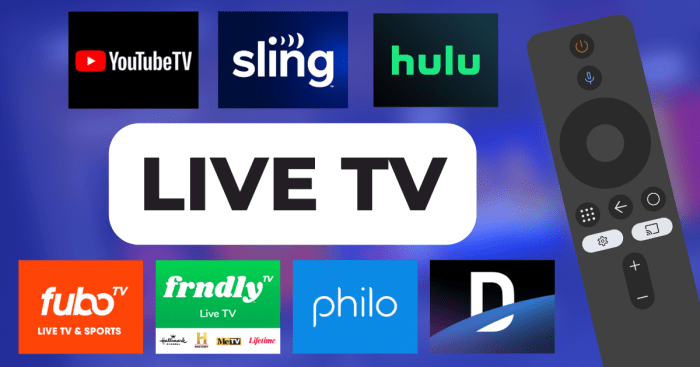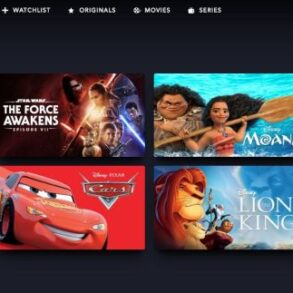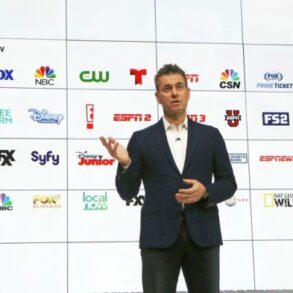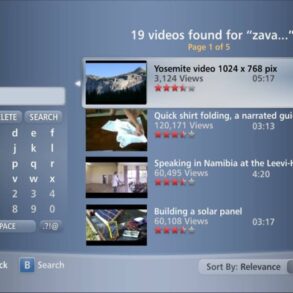YouTube TV bringing multiview to live TV streaming is a game-changer. Imagine watching a sporting event, a news broadcast, or any live show from multiple angles simultaneously. This innovative feature promises a more engaging and comprehensive viewing experience, potentially disrupting the current streaming landscape. From a technical perspective, multiview demands significant infrastructure, but the potential benefits for viewers are enormous.
The ability to see different perspectives and zoom in on key players or developments offers an exciting leap forward.
This new feature will likely be a focal point of competition in the streaming world. The detailed analysis of its technical requirements, user experience, and potential applications will provide a comprehensive understanding of its impact on the industry.
Introduction to Multiview on YouTube TV

YouTube TV’s foray into multiview live streaming represents a significant advancement in the viewer experience. This innovative feature promises to revolutionize how viewers interact with live television, offering unprecedented flexibility and engagement. By allowing simultaneous viewing of multiple channels or angles, multiview opens up a whole new dimension of entertainment possibilities.Multiview on YouTube TV offers a dynamic alternative to the traditional linear television experience.
Instead of being confined to a single perspective, viewers can choose from various camera angles or channels, effectively creating a personalized viewing experience. This flexibility can be particularly appealing to sports fans, who might want to follow different plays from various angles simultaneously, or to families who might want to watch different programs at once. This feature also caters to the ever-growing demand for personalized content consumption.
Potential Benefits for Viewers
Multiview provides viewers with a significantly enhanced viewing experience. The ability to switch between different channels or angles allows for a more interactive and engaging way to consume live content. This is especially beneficial for events like sporting matches, where viewers can see different aspects of the game simultaneously. Moreover, families or individuals with shared viewing spaces can benefit from this feature, enjoying a more dynamic and inclusive viewing experience.
By allowing viewers to focus on different aspects of the same event, multiview caters to varied interests and viewing preferences.
How Multiview Differs from Traditional Live TV Streaming
Traditional live TV streaming often limits viewers to a single channel or perspective. Multiview, on the other hand, empowers viewers to actively participate in the viewing process, selecting from multiple angles or channels. This crucial difference sets multiview apart, providing viewers with an unprecedented degree of control and customization. The ability to choose what to watch and when enhances the overall viewing experience.
Impact on the Competitive Landscape
The introduction of multiview is expected to significantly impact the competitive landscape of streaming services. The unique feature offers a compelling differentiator, potentially attracting new subscribers and retaining existing ones. Other services may be prompted to adopt similar innovations to maintain competitiveness. The ability to offer a more immersive and engaging live TV experience can be a significant advantage in a market increasingly focused on personalization and interactive content.
YouTube TV’s new multiview feature for live streaming is pretty cool, offering a fresh take on watching TV. Meanwhile, the recent news about Stability AI CEO Emad Mostaque’s resignation and the shift towards decentralized AI, found here , is certainly shaking things up in the tech world. Hopefully, this innovative multiview feature will continue to enhance the viewing experience without any major technical hiccups, though.
Companies like Netflix and Hulu, which are currently focused on on-demand content, might also consider integrating multiview into their live streaming offerings.
Comparison of Multiview with Other Streaming Features
| Feature | Multiview | Other Streaming Features (e.g., DVR, Live Channels) |
|---|---|---|
| Core Function | Simultaneous viewing of multiple channels/angles | Recording and playback of live content/access to a library of channels |
| Viewer Interaction | Highly interactive, allows viewers to customize their viewing experience | Less interactive, focuses on passive consumption |
| Potential Impact | Potential to revolutionize live TV streaming, create a more engaging and personalized viewing experience | Improved viewing convenience, ability to watch content at a later time |
This table highlights the key distinctions between multiview and other prevalent streaming features. It underscores how multiview offers a new level of engagement and customization not readily available in other services. The interactive nature of multiview stands in contrast to the more passive nature of traditional live streaming and DVR functionality.
Technical Aspects of Implementing Multiview
Bringing multiview to live TV streaming on a platform like YouTube TV involves a complex interplay of technical considerations. The ability to display multiple camera angles simultaneously, while maintaining a seamless viewing experience, requires a robust infrastructure and sophisticated engineering. This intricate process demands a deep understanding of video encoding, transmission, and display protocols.The core challenge lies in balancing the need for high-quality video across multiple streams with the limitations of bandwidth and latency.
A smooth multiview experience relies on the efficient delivery of different camera angles, while also ensuring that each angle is displayed with appropriate resolution and frame rate to avoid pixelation or choppiness. Delivering a superior multiview experience is crucial for viewers to fully appreciate the action unfolding.
Technical Requirements for Multiview Support
The implementation of multiview requires significant investment in infrastructure. Robust server-side processing is needed to manage the encoding and streaming of multiple video feeds simultaneously. This necessitates powerful hardware and sophisticated software to handle the massive data volume generated by multiple camera angles. High-performance storage is essential to cache and deliver video streams quickly.
Potential Challenges in Implementing Multiview
Bandwidth limitations are a major concern. Transmitting multiple high-definition video streams simultaneously consumes considerable bandwidth. Adaptive streaming techniques are crucial to address this challenge. Dynamically adjusting the bitrate and resolution of each stream based on the viewer’s network conditions is essential for providing a good quality of experience (QoE). Real-time monitoring and optimization algorithms are needed to ensure that the bandwidth usage remains within acceptable limits.Latency is another significant hurdle.
The delay between capturing the video feed and displaying it to the viewer must be minimized to avoid a jarring viewing experience. Lowering latency requires optimization at each stage of the streaming pipeline, from camera capture to viewer display. This includes reducing encoding times, optimizing network routes, and utilizing content delivery networks (CDNs) for fast content delivery. Optimizing the multiview architecture to minimize latency is critical for providing a fluid viewing experience.
Infrastructure Needed for Multiview Functionality
A robust content delivery network (CDN) is essential for delivering multiview streams efficiently to viewers worldwide. The CDN needs to be capable of handling the high volume of data traffic associated with multiple video streams. Furthermore, a sophisticated monitoring system is required to track the performance of the multiview platform, identifying bottlenecks, and ensuring the optimal delivery of video streams.
The multiview architecture should be designed with scalability in mind to accommodate future growth and the increasing demands of users.
Adaptive Streaming Techniques for Optimal Multiview Performance
Adaptive streaming allows the platform to adjust the quality of the video stream in real-time based on the viewer’s internet connection. This ensures that viewers with slower connections still have a satisfactory viewing experience, while viewers with faster connections can enjoy high-quality video. This dynamic adaptation to network conditions is crucial for delivering a consistent multiview experience to a diverse audience.
Different video encoding formats (e.g., H.264, H.265) are employed, with appropriate scaling and resolution adjustments to match the network capacity.
Resolutions and Frame Rates Supported by Multiview
| Resolution | Frame Rate | Description |
|---|---|---|
| 1080p | 30fps | Standard high definition resolution, suitable for most viewers |
| 1080p | 60fps | Higher frame rate for smoother motion, especially important for fast-paced action |
| 4K | 30fps | Ultra high definition resolution for a superior visual experience |
| 4K | 60fps | Ultra high definition resolution with higher frame rate for even smoother motion |
The table above illustrates a range of resolutions and frame rates. The choice of resolution and frame rate depends on the specific application and the requirements for the viewer experience. Factors such as content type, network conditions, and viewer preferences influence the optimal choice.
User Experience with Multiview
YouTube TV’s introduction of multiview streaming promises a revolutionary approach to live TV viewing. Beyond the technical aspects, understanding user preferences and crafting a seamless user interface are critical to the success of this new feature. A well-designed multiview experience can significantly enhance engagement and satisfaction, potentially transforming how users interact with live events.
Potential User Preferences and Needs
User preferences for multiview functionality vary widely. Some users might appreciate the ability to follow multiple storylines or perspectives simultaneously, especially during sporting events or news broadcasts. Others may find the complexity of multiview overwhelming, preferring the simplicity of a single-view presentation. The design must cater to both these needs, offering options for adjusting the layout and the number of concurrent streams.
Accessibility features, such as adjustable font sizes and color palettes, are also essential for a wider audience.
User Interface Design Examples
A well-designed multiview interface should allow for easy navigation and control. Imagine a user interface where different streams are represented by distinct, clearly labeled windows, each with adjustable size and position. Overlayed information, such as player stats or news ticker feeds, could be displayed without obstructing the main view. The ability to quickly switch between different camera angles or channels is paramount.
Further, a simple menu system allowing users to customize the display, selecting specific camera feeds, or even arranging the layout of the multiview windows would be beneficial.
Enhancement of User Engagement and Enjoyment
Multiview can significantly enhance user engagement by providing more options and perspectives. For instance, during a live sporting event, a user could follow the action on the field while simultaneously monitoring the game’s commentary and the reactions of the crowd. This kind of interactive view could make the event more dynamic and enjoyable, fostering a deeper connection with the content.
YouTube TV’s new multiview feature for live streaming is pretty cool, letting you watch different angles simultaneously. Thinking about how to keep your phone’s battery topped up while watching, though, a great option is a wireless charging battery case, like the ones for the iPhone XS Max, XR. apple iphone xs max xr battery case wireless charging provides extra juice, perfect for marathon streaming sessions of your favorite live shows, ensuring you don’t miss a single moment of the multiview action.
The same principles apply to other live programs, such as news broadcasts or concerts.
Comparison with Single-View Streaming
Single-view streaming offers simplicity and ease of use, often favored by those who prefer a straightforward presentation. However, multiview provides a richer, more immersive experience, allowing for a more comprehensive understanding of the event. It’s akin to the difference between a static photograph and a dynamic video, offering multiple angles and perspectives. The choice between single-view and multiview depends on the user’s individual needs and preferences.
Multiview Layouts and Potential Uses
| Layout | Potential Use Cases |
|---|---|
| Side-by-Side | Sporting events (main action and commentary), live concerts (main stage and audience), news broadcasts (multiple reporters). |
| Stacked | Interviews, panel discussions, multi-camera coverage of a single event (e.g., a political debate), or live-streamed events with different stages. |
| Grid | Broadcasting multiple concurrent events or segments (e.g., a news channel showing multiple news stories at once). Multi-channel programming, where the user can view several shows simultaneously. |
| Panoramic | Large-scale events (e.g., a large-scale festival), virtual tours, or viewing multiple viewpoints simultaneously during an outdoor event. |
This table illustrates the diverse possibilities of multiview layouts, highlighting how they can cater to different types of live content and user preferences. Each layout offers unique advantages and contributes to a richer and more engaging viewing experience.
YouTube TV’s new multiview feature for live streaming is pretty cool, right? It’s like having multiple screens for different angles, but imagine the possibilities if this tech could be used for something else like comparing the PS4 Slim to the original PS4. You can easily find out the differences between these two consoles by checking out this detailed comparison: playstation 4 slim vs ps4.
Ultimately, this multiview approach for live TV could become a game-changer, offering a lot more flexibility in how we watch.
Potential Applications and Use Cases: Youtube Tv Bringing Multiview To Live Tv Streaming
YouTube TV’s multiview feature promises a revolution in live TV viewing, offering a dynamic and engaging experience for a diverse range of viewers. This capability extends beyond the traditional single-screen presentation, allowing users to access multiple perspectives simultaneously. This opens up a wealth of possibilities across various genres of live programming, from sports to news to educational content.
The potential for enhanced engagement and accessibility is significant.The implementation of multiview on YouTube TV allows viewers to see different angles of the same event, enabling a more comprehensive understanding and appreciation of the action. This feature is particularly valuable for live events with complex action, such as sports games or news broadcasts, and provides a significantly richer viewing experience for all involved.
Potential Applications in Sports Viewing
Multiview in sports broadcasting can provide a significantly enhanced viewing experience. By showcasing multiple camera angles, viewers can follow the game from various perspectives. For example, a viewer could see the play from the field-level angle, the sideline view, and a drone shot simultaneously. This gives viewers a more comprehensive view of the action and allows for a more dynamic and interactive experience.
Furthermore, highlights of plays can be captured from different angles, enhancing the overall quality of the replay. Detailed analysis of player performance is significantly improved with the ability to analyze different angles.
Potential Applications in News Broadcasts
Multiview functionality in news broadcasts can offer viewers an unparalleled insight into events unfolding live. For example, a multiview presentation could display the reporter on-site, the studio anchor, and a live feed from the location of the event. This allows viewers to follow the news development from different locations and perspectives, enhancing their understanding of the story. News broadcasts can include multiview during interviews with multiple sources, providing a more nuanced and detailed account of the event.
Such capabilities allow for a more immersive and interactive experience for the news viewer.
Potential Applications in Other Live Events
Multiview’s benefits extend to other live events. During concerts or award ceremonies, viewers could see the performers from different stage angles or from the audience’s perspective, creating a more immersive experience. In educational programming, multiview can allow simultaneous display of different speakers, visuals, or experiments, facilitating better comprehension and engagement.
Benefits for Specific Viewer Groups
Multiview is designed to enhance the viewing experience for diverse audiences. Families with children can benefit from the ability to follow multiple aspects of a program. Sports fans can gain a deeper understanding of the game’s intricacies. People with visual impairments could benefit from multiview by enabling them to see the event from different perspectives. This provides a more inclusive viewing experience for everyone.
Benefits for Remote Viewers
Remote viewers gain access to a broader range of angles and perspectives. They can follow events as if they were present, increasing the sense of immersion. The ability to access various perspectives, especially during news broadcasts or sporting events, can make the experience feel more interactive.
Summary Table of Potential Applications
| Live Event Category | Potential Multiview Use Cases |
|---|---|
| Sports | Multiple camera angles, replay highlights from different views, analysis of player performance |
| News | Simultaneous display of reporter on-site, studio anchor, and live feed from event location, multiple interview sources |
| Concerts/Award Ceremonies | Different stage angles, audience perspective |
| Educational Programming | Simultaneous display of speakers, visuals, experiments |
Comparison with Existing Multiview Services
YouTube TV’s foray into multiview live streaming brings a compelling new feature to the table, but how does it stack up against the competition? This comparison delves into the offerings of other streaming services, examining their features, capabilities, and potential advantages and disadvantages to paint a clearer picture of YouTube TV’s position in the market. Understanding the landscape of existing multiview services provides valuable context for evaluating YouTube TV’s innovative approach.
Existing Multiview Service Features
A significant number of streaming services are exploring multiview, each with its own strengths and weaknesses. Direct comparisons highlight the diversity of features and functionalities. These varying implementations reflect the evolving demands of users and the challenges of presenting multiple perspectives effectively within a streaming environment. Some services focus on simplicity, while others prioritize advanced features.
Comparison Table
| Streaming Service | Multiview Features | User Experience | Potential Advantages | Potential Disadvantages |
|---|---|---|---|---|
| Netflix | Limited multiview support, primarily for certain interactive content like documentaries. Often focuses on alternative viewing angles, rather than simultaneous live viewing of different perspectives. | User experience is tailored to the interactive nature of the content. | Provides alternative perspectives and interactive features for specific content. | Limited use cases and less emphasis on live, simultaneous multiview. |
| ESPN+ | Offers multiview options for some live sports events, particularly those with multiple cameras capturing the action from different angles. | Provides valuable insights for sports enthusiasts, especially in events with multiple cameras. | Allows users to get a complete view of the action, important for sports. | Limited to specific content types and not consistently available across all events. |
| YouTube TV | Provides simultaneous viewing of multiple camera angles, potentially supporting multiple simultaneous views of different events. | Potentially enhances the live viewing experience, offering a broader understanding of the event. | Potentially broader applications, enabling simultaneous viewing of multiple events or perspectives, such as different sports games. | Might require significant infrastructure to support the complexity of simultaneously displaying multiple live feeds. |
| Other Live Streaming Services (e.g., Sling TV, Hulu Live TV) | Limited or no multiview support. May offer some basic split-screen options but lack the dynamic multiple perspectives available in dedicated multiview services. | User experience is limited to the available standard viewing options. | Simplicity of the interface may be an advantage for some users. | Users seeking multiple perspectives or simultaneous events might find this feature lacking. |
Potential Advantages of YouTube TV’s Approach
YouTube TV’s multiview approach could offer advantages over existing services by providing more flexibility and customization in viewing multiple perspectives simultaneously. This could extend beyond sports to other live events or programs with multiple cameras, opening up possibilities for viewers to customize their viewing experience. A user-friendly interface for selecting and arranging multiple feeds would be crucial for maximizing the benefits.
Potential Disadvantages of YouTube TV’s Approach
The implementation of multiview on a large scale, like YouTube TV’s potential, might face challenges in terms of bandwidth and server infrastructure. Ensuring a seamless and high-quality viewing experience for multiple simultaneous feeds would require significant resources and technical expertise. The user interface design for managing multiple feeds needs careful consideration to avoid overwhelming or confusing users.
Future Implications of Multiview
Multiview technology, offering multiple camera angles simultaneously, is poised to revolutionize the streaming landscape. Beyond its immediate appeal for sports and live events, its potential impact on content creation, viewer habits, and the streaming industry as a whole is profound. This exploration delves into the exciting possibilities that lie ahead.The integration of multiview into streaming platforms like YouTube TV marks a significant step forward, promising a more immersive and interactive viewing experience.
This shift from a single perspective to a dynamic array of angles has far-reaching consequences, impacting not only how we consume content but also how it’s produced and distributed.
Potential Impact on Content Creation
The availability of multiview will undoubtedly influence content creators. The ability to capture and present diverse perspectives will empower producers to tell stories more effectively and engage audiences in unprecedented ways. For instance, in a cooking show, viewers could see the chef’s hands, the ingredients being prepared, and the finished dish all at once. This expanded perspective adds depth and engagement, potentially transforming how shows are structured and presented.
Future Developments in Multiview Technology
Advancements in camera technology, including higher resolution, improved image stabilization, and integration with AI, will likely propel multiview forward. Imagine multiview that seamlessly adapts to the action, dynamically switching angles based on the movement of players or characters in real-time, enhancing the viewer’s experience. Furthermore, integration with virtual reality (VR) technology could create truly immersive multiview experiences.
Potential Impact on Viewer Habits
Multiview’s influence on viewer habits is likely to be substantial. Increased immersion will attract a wider range of viewers. This will lead to a greater demand for content featuring multiview functionality. The ability to see multiple angles simultaneously will encourage viewers to pay closer attention to details and subtleties that might be missed in a single-camera perspective. For instance, viewers of sporting events might focus more on the strategies of different teams or individual player performances.
Emerging Trends in Multiview Functionality
The rise of interactive elements within multiview is a promising trend. Imagine viewers being able to switch between cameras, zoom in on specific areas, or even comment on what they’re seeing. This interactivity will create a more participatory viewing experience, transforming passive consumption into an active engagement with the content. Additionally, real-time highlighting of key moments or statistics within the multiview feed will provide enhanced context and understanding for viewers.
Long-Term Impact on the Streaming Industry
Multiview is expected to fundamentally reshape the streaming industry. Its ability to offer a more dynamic and engaging viewing experience will drive competition and innovation in the streaming sector. This new perspective on live content will lead to an increase in the production of multiview-ready programming, ultimately benefiting both content creators and viewers. For example, news broadcasts might employ multiview to show different angles of a breaking news story, providing a more comprehensive and detailed understanding of the event.
Potential Impact on the Streaming Ecosystem

YouTube TV’s introduction of multiview streaming technology presents a significant opportunity and challenge for the entire streaming landscape. The ability to simultaneously view multiple angles and perspectives during live events will undoubtedly reshape how viewers engage with live content, potentially influencing the strategies and offerings of competitors. This innovation promises to revolutionize live sports viewing, news coverage, and more, while also presenting opportunities and challenges for content creators and the broadcasting industry.
Impact on Other Streaming Services, Youtube tv bringing multiview to live tv streaming
The introduction of multiview on YouTube TV will likely trigger a ripple effect throughout the streaming ecosystem. Competitors will be compelled to either adopt similar features or enhance their existing offerings to remain competitive. This competitive pressure will likely drive innovation and potentially lead to a broader adoption of multiview technology across various streaming platforms. The inclusion of multiview functionality could attract new users to streaming services and potentially enhance user engagement, potentially leading to increased subscriptions and revenue.
Competitive Pressures and Strategies
Streaming services will face significant competitive pressure to match or surpass YouTube TV’s multiview capabilities. This could involve developing their own multiview platforms, integrating existing multi-camera streaming solutions, or partnering with other companies to offer similar features. A key competitive strategy for other services might be to offer specialized multiview options tailored to specific genres, such as providing detailed camera angles for sports broadcasts or alternative perspectives for news coverage.
This could differentiate their services and potentially attract specific segments of the audience.
Changes in Live Content Consumption
Multiview technology has the potential to fundamentally alter how people consume live content. Viewers might gravitate towards services offering multiview capabilities, seeking greater depth and understanding of events. This could lead to a rise in the demand for live events with multiple camera angles and perspectives, potentially impacting the types of live programming that are produced and distributed. The flexibility and interactivity of multiview might encourage more active participation from viewers, who can choose the perspective that resonates most with them.
Impact on Content Creators
Content creators will need to adapt to the demands of multiview streaming. They may need to invest in additional cameras, production equipment, and potentially, new editing and distribution workflows to deliver high-quality multiview content. This will likely present opportunities for specialized content creators, like sports commentators, who can leverage multiple perspectives to enhance their analyses and provide more comprehensive coverage.
The potential for higher production costs might also lead to some creators choosing to forgo multiview, focusing instead on single-camera setups, especially if they do not anticipate significant returns.
Impact on the Broadcasting Industry
The broadcasting industry will face a paradigm shift as multiview technology becomes more prevalent. Traditional broadcasting models might be challenged by the ability of streaming services to offer more flexible and interactive viewing experiences. Broadcasting companies will need to adapt by potentially integrating multiview capabilities into their live productions or partnering with streaming services to distribute their content in a multiview format.
This could result in a greater demand for skilled multi-camera production and editing professionals.
Potential Impact on Different Stakeholders
| Stakeholder | Potential Impact |
|---|---|
| Streaming Services | Increased competition, potential for new revenue streams, need for investment in infrastructure and content creation |
| Content Creators | Increased production costs, need to adapt to new production standards, opportunities for specialized content |
| Viewers | Enhanced viewing experience, more interactive engagement, greater access to diverse perspectives |
| Broadcasting Industry | Potential shift towards more interactive formats, need to adapt to new distribution models, increased demand for skilled professionals |
Closing Summary
YouTube TV’s introduction of multiview live streaming marks a significant advancement in how we consume live content. The ability to view events from multiple angles will undoubtedly change the way we watch sports, news, and other live broadcasts. While the technical challenges are substantial, the potential for enhanced engagement and a more immersive experience for viewers is undeniable. The future of live streaming may well be multi-faceted, thanks to this innovative approach.












